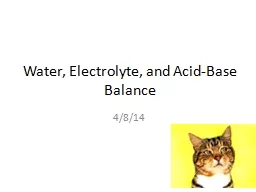

4814 Balance Water and electrolytes molecules that release ions in water must maintain a balance of quantities coming in and leaving Mechanisms in the body are responsible for this balance ID: 273254
Download Presentation The PPT/PDF document "Water, Electrolyte, and Acid-Base Balanc..." is the property of its rightful owner. Permission is granted to download and print the materials on this web site for personal, non-commercial use only, and to display it on your personal computer provided you do not modify the materials and that you retain all copyright notices contained in the materials. By downloading content from our website, you accept the terms of this agreement.
Slide1
Water, Electrolyte, and Acid-Base Balance
4/8/14Slide2
Balance
Water and
electrolytes
(molecules that release ions in water) must maintain a balance of quantities coming in and leaving.Mechanisms in the body are responsible for this balanceWater and electrolyte balance interdependentElectrolytes are dissolved in waterAnything that alters electrolyte concentration will alter the concentration of water.Slide3
Fluid Compartments
Intracellular fluid compartments
All the water and electrolytes that cell membranes enclose (fluid inside of cells)
63% of total body water by volume
Extracellular fluid compartments 37% by volumeall of the fluids outside cells.
Tissues, blood vessels, lymphatic vessels
Transcellular
fluid = cerebrospinal fluid, fluids in the eye, joints, glands, and body cavities. Slide4
Water Balance
Exists when water intake equals water output.Depends on our thirst centers in the brain to vary water intake and on the kidney’s ability to vary water output.Slide5
Water Intake
Average adult takes in about 2,500 milliliters of water daily.60% by drinking water or beverages30% comes from moist foods
10% is a by-product of the oxidative metabolism of nutrients =
water of metabolismSlide6
Regulation of Water Intake
Primary regulator of water intake is thirst.
Thirst center is in the hypothalamus of the brain.
A thirsty person usually has a dry mouth caused by loss of extracellular water and the resulting decreased flow of saliva.
Thirst mechanism is normally triggered whenever the total body water decreases by as little as 1%.Act of drinking water distends the stomach triggering nerve impulses that inhibit the thirst mechanism.Slide7
Water Output
Water normally enters the body through the mouth, but can be lost through a variety of routes.Urine, feces, sweat, evaporation from the skin, lungs during breathing
60% urine, 6% feces, 6% sweat. 28% lost through skin and lungs.
These percentages will change with level of physical activity, environment, etc.Slide8
Regulation of Water Output
Sweat, feces, and evaporation are necessary functions (cooling, waste elimination).Thus, primary regulation of water output is urine production.
If a person takes in too much water, urine production increases to maintain the balance, vice versa.
Caffeine inhibits the reabsorption of sodium ions and other solutes, resulting in increased urine volume.